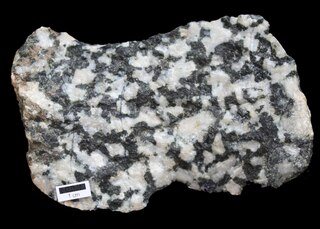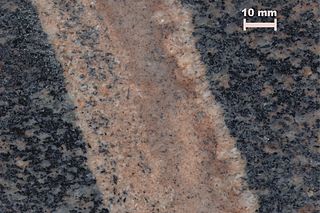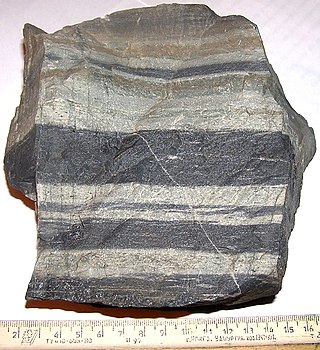
Napoleonite is a variety of diorite (also called corsite because the stone is found in the island of Corsica). [1]

Napoleonite is a variety of diorite (also called corsite because the stone is found in the island of Corsica). [1]
Napoleonite is a variety of diorite which is characterized by orbicular structure. The grey matrix of the stone has the normal appearance of a diorite, but contains many rounded lumps 1 or 2 inches in diameter, which show concentric zones of light and dark colors. In these spheroids also a distinct and well-marked radial arrangement of the crystals is apparent. The center of the spheroid is usually white or pale grey and consists mainly of feldspar; the same mineral makes the pale zones while the dark ones are rich in hornblende and pyroxene. The feldspar is a basic variety of plagioclase (anorthite or bytownite). Though mostly rounded, the spheroids may be elliptical or subangular; sometimes they are in contact with one another but usually they are separated by small areas of massive diorite. [1]
When cut and polished the rock makes a beautiful and striking ornamental stone. It has been used for making paperweights and other small ornamental articles. [1]
Spheroidal structure is found in other diorites and in quite a number of granites in various places, such as Sweden, Russia, America, Sardinia and Ireland. It is by no means common, however, and usually occurs in only a small part of a granitic or dioritic mass, being sometimes restricted to an area of a few square yards. In most cases it is found near the center of the outcrop, though exceptionally it has been found quite close to the margin. It arises evidently from intermittent and repeated crystallization of the rock-forming minerals in successive stages. [1]
Such a process would be favored by complete rest, which would allow of supersaturation of the magma by one of the components. Rapid crystallization would follow, producing deposits on any suitable nuclei, and the crystals then formed might have a radial disposition on the surfaces on which they grew. The magma might then be greatly impoverished in this particular substance, and another deposit of a different kind would follow, producing a zone of different color. The nucleus for the spheroidal growth is sometimes an early porphyritic crystal, sometimes an enclosure of gneiss, et cetera, and often does not differ essentially in composition from the surrounding rock. When spheroids are in contact their inner zones may be distinct while the outer ones are common to both individuals having the outlines of a figure of eight. This proves that growth was centrifugal, not centripetal. Many varieties of spheroids are described presenting great differences in composition and in structure. Some are merely rounded balls consisting of the earliest minerals of the rock, such as apatite, zircon, biotite and hornblende, and possessing no regular arrangement. Others have as centers a foreign fragment such as gneiss or hornfels, with one or more zones, pale or dark, around this. Radial arrangement of the crystals, though often very perfect, is by no means universal. The spheroids are sometimes flattened or egg-shaped, apparently by the flow of magma at a time when they were semi-solid or plastic. As a general rule the spheroids are more basic and richer in the iron-magnesium minerals than the surrounding rock, though some of the zones are often very rich in quartz and feldspar. Graphic or perthitic intergrowths between the minerals of a zone are frequent. The spheroids vary in width up to 1 or 2 ft. In some cases they contain abnormal constituents such as calcite, sillimanite or corundum. [1]

Granite is a coarse-grained (phaneritic) intrusive igneous rock composed mostly of quartz, alkali feldspar, and plagioclase. It forms from magma with a high content of silica and alkali metal oxides that slowly cools and solidifies underground. It is common in the continental crust of Earth, where it is found in igneous intrusions. These range in size from dikes only a few centimeters across to batholiths exposed over hundreds of square kilometers.

Hornblende is a complex inosilicate series of minerals. It is not a recognized mineral in its own right, but the name is used as a general or field term, to refer to a dark amphibole. Hornblende minerals are common in igneous and metamorphic rocks.

Trachyte is an extrusive igneous rock composed mostly of alkali feldspar. It is usually light-colored and aphanitic (fine-grained), with minor amounts of mafic minerals, and is formed by the rapid cooling of lava enriched with silica and alkali metals. It is the volcanic equivalent of syenite.

Migmatite is a composite rock found in medium and high-grade metamorphic environments, commonly within Precambrian cratonic blocks. It consists of two or more constituents often layered repetitively: one layer is an older metamorphic rock that was reconstituted subsequently by partial melting ("neosome"), while the alternate layer has a pegmatitic, aplitic, granitic or generally plutonic appearance ("paleosome"). Commonly, migmatites occur below deformed metamorphic rocks that represent the base of eroded mountain chains.

Amphibolite is a metamorphic rock that contains amphibole, especially hornblende and actinolite, as well as plagioclase feldspar, but with little or no quartz. It is typically dark-colored and dense, with a weakly foliated or schistose (flaky) structure. The small flakes of black and white in the rock often give it a salt-and-pepper appearance.

Nepheline syenite is a holocrystalline plutonic rock that consists largely of nepheline and alkali feldspar. The rocks are mostly pale colored, grey or pink, and in general appearance they are not unlike granites, but dark green varieties are also known. Phonolite is the fine-grained extrusive equivalent.

Diorite is an intrusive igneous rock formed by the slow cooling underground of magma that has a moderate content of silica and a relatively low content of alkali metals. It is intermediate in composition between low-silica (mafic) gabbro and high-silica.

Aplite is an intrusive igneous rock in which the mineral composition is the same as granite, but in which the grains are much finer, under 1 mm across. Quartz and feldspar are the dominant minerals. The term aplite or aplitic is often used as a textural term to describe veins of quartz and feldspar with a fine to medium-grain "sugary" texture. Aplites are usually very fine-grained, white, grey or pinkish, and their constituents are visible only with the help of a magnifying lens. Dykes and veins of aplite are commonly observed traversing granitic bodies; they occur also, though less frequently, in syenites, diorites, quartz diabases, and gabbros.

The scapolites are a group of rock-forming silicate minerals composed of aluminium, calcium, and sodium silicate with chlorine, carbonate and sulfate. The two endmembers are meionite and marialite. Silvialite (Ca,Na)4Al6Si6O24(SO4,CO3) is also a recognized member of the group.

Granulites are a class of high-grade metamorphic rocks of the granulite facies that have experienced high-temperature and moderate-pressure metamorphism. They are medium to coarse–grained and mainly composed of feldspars sometimes associated with quartz and anhydrous ferromagnesian minerals, with granoblastic texture and gneissose to massive structure. They are of particular interest to geologists because many granulites represent samples of the deep continental crust. Some granulites experienced decompression from deep in the Earth to shallower crustal levels at high temperature; others cooled while remaining at depth in the Earth.

Hornfels is the group name for a set of contact metamorphic rocks that have been baked and hardened by the heat of intrusive igneous masses and have been rendered massive, hard, splintery, and in some cases exceedingly tough and durable. These properties are due to fine grained non-aligned crystals with platy or prismatic habits, characteristic of metamorphism at high temperature but without accompanying deformation. The term is derived from the German word Hornfels, meaning "hornstone", because of its exceptional toughness and texture both reminiscent of animal horns. These rocks were referred to by miners in northern England as whetstones.

Lamprophyres are uncommon, small-volume ultrapotassic igneous rocks primarily occurring as dikes, lopoliths, laccoliths, stocks, and small intrusions. They are alkaline silica-undersaturated mafic or ultramafic rocks with high magnesium oxide, >3% potassium oxide, high sodium oxide, and high nickel and chromium.

Charnockite is any orthopyroxene-bearing quartz-feldspar rock formed at high temperature and pressure, commonly found in granulite facies’ metamorphic regions, sensu stricto as an endmember of the charnockite series.

Granodiorite is a coarse-grained (phaneritic) intrusive igneous rock similar to granite, but containing more plagioclase feldspar than orthoclase feldspar.
Restite is the residual material left at the site of melting during the in place production of granite through intense metamorphism.
This glossary of geology is a list of definitions of terms and concepts relevant to geology, its sub-disciplines, and related fields. For other terms related to the Earth sciences, see Glossary of geography terms.

The geology of Alderney includes similarities in its rock to the neighbouring Normandy and Guernsey. Although Alderney is only five kilometers long, it has a geological history spanning half of the life of the earth. It is part of the Armorican Massif.
The Piégut-Pluviers Granodiorite is situated at the northwestern edge of the Variscan Massif Central in France. Its cooling age has been determined as 325 ± 14 million years BP.
I-type granites are a category of granites originating from igneous sources, first proposed by Chappell and White (1974). They are recognized by a specific set of mineralogical, geochemical, textural, and isotopic characteristics that indicate, for example, magma hybridization in the deep crust. I-type granites are saturated in silica but undersaturated in aluminum; petrographic features are representative of the chemical composition of the initial magma. In contrast S-type granites are derived from partial melting of supracrustal or "sedimentary" source rocks.